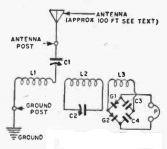60 years ago, CONELRAD was the system planned for keeping the American public informed in the event of a nuclear attack. As I’ve explained previously, the idea was for designated broadcast stations to operate on 640 or 1240 kHz. Stations would not transmit station identification, transmissions from individual stations would be short, and enemy bombers would be presented with a cacophony of signals useless for navigation purposes.
But power might be out. Battery-operated sets were rare, and most of those that existed sucked through expensive batteries quickly, since they had to power the filaments of the tubes. Undaunted, radio enthusiasts realized that a crystal set could be put to use. As I previously reported, Boys’ Life magaine touted a crystal set that could be put to use in an emergency.
Another Boys’ Life article included a CONELRAD receiver with one transistor that could run on two penlight batteries. And in a pinch, that set could be used without a battery, operating as a simple crystal set. And during the 1956 CONELRAD test, a Heathkit crystal set performed surprisingly well at receiving the emergency broadcasts, even outperforming commercial tube and transistor radios.
 Another example of crystal sets for emergency use is shown here, in the 1955 edition of Radio-TV Experimenter. Author George P. Pearce (probably shown in the illustration above) describes the need:
Another example of crystal sets for emergency use is shown here, in the 1955 edition of Radio-TV Experimenter. Author George P. Pearce (probably shown in the illustration above) describes the need:
If flood, tornado or air raids cause power failures, could you get emergency directions from the Conelrad stations the government has at 640 and 1240 on the dial? Even battery-powered sets couldn’t operate over an extended period of weeks, so why not build a crystal set that needs no power except the broadcast signal.
The author describes this set, which uses two 1N35 diodes along with two .001 uF capacitors in a voltage-doubler circuit. It uses basket-wound high-Q coils to pull in weak signals. It recommends a 100 foot antenna and good ground. He also suggests the use of the house wiring as an antenna, using a lamp cord, capacitor, and plug going in to the 120 volt house wiring. This ought to work, but if the power is on, you would be putting a lot of faith in that capacitor not being leaky as you put the headphones hooked to that antenna onto your head, just like they place the electrode of an electric chair.
The author notes that there’s nothing to wear out, and his set has operated for over three years.
Click Here For Today’s Ripley’s Believe It Or Not Cartoon
![]()

